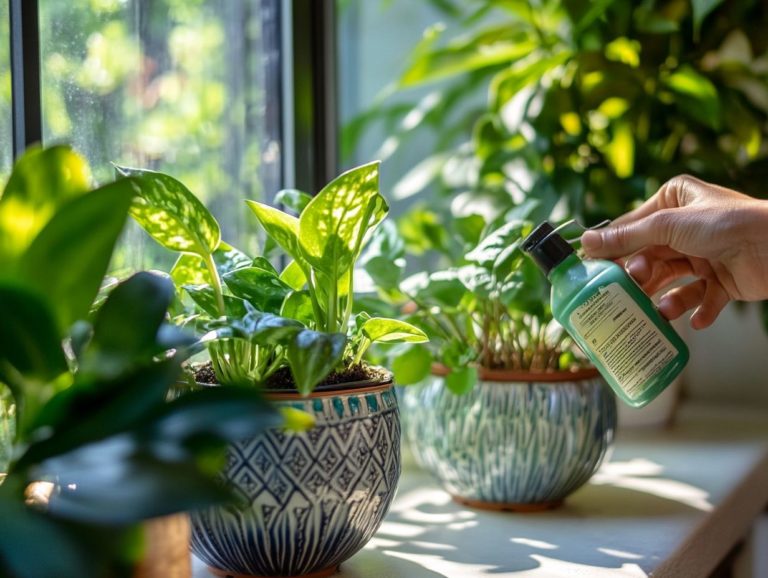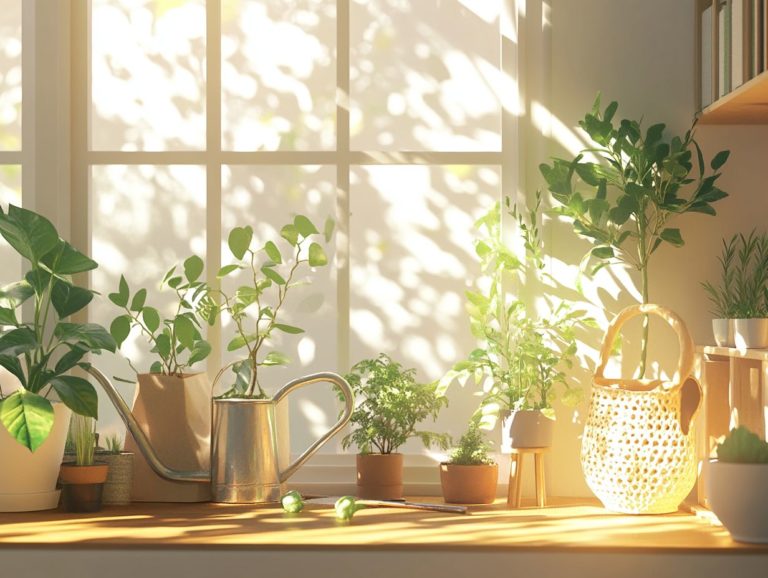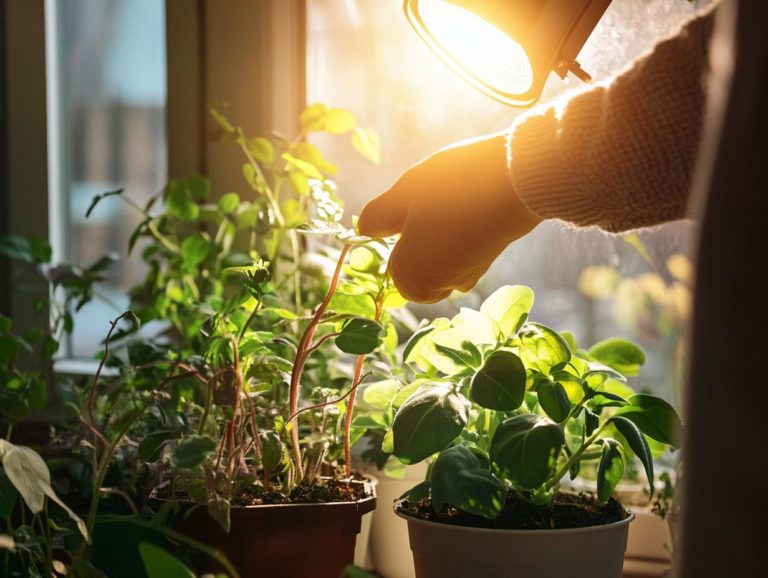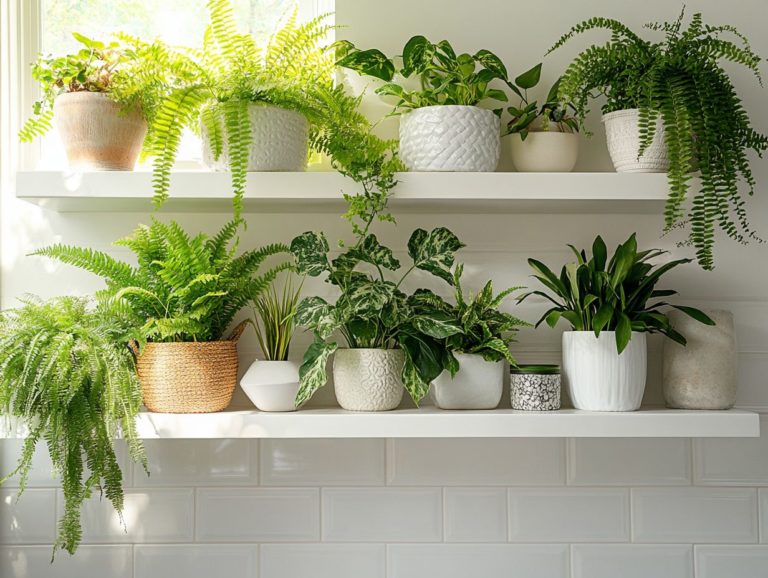What are the Best Indoor Plants for Beginners?
Indoor plants infuse any space with a breath of fresh air, delivering not only aesthetic charm but also many health benefits.
By purifying the air and uplifting your mood, incorporating greenery into your home can profoundly transform your environment. If you’re just starting your plant care journey, opt for varieties that are easy to manage and well-suited to your specific conditions.
This guide will equip you with essential tips, highlight common pitfalls to avoid, and recommend the best plants for various settings. It will empower you to cultivate a thriving indoor garden with confidence.
Contents
Key Takeaways:
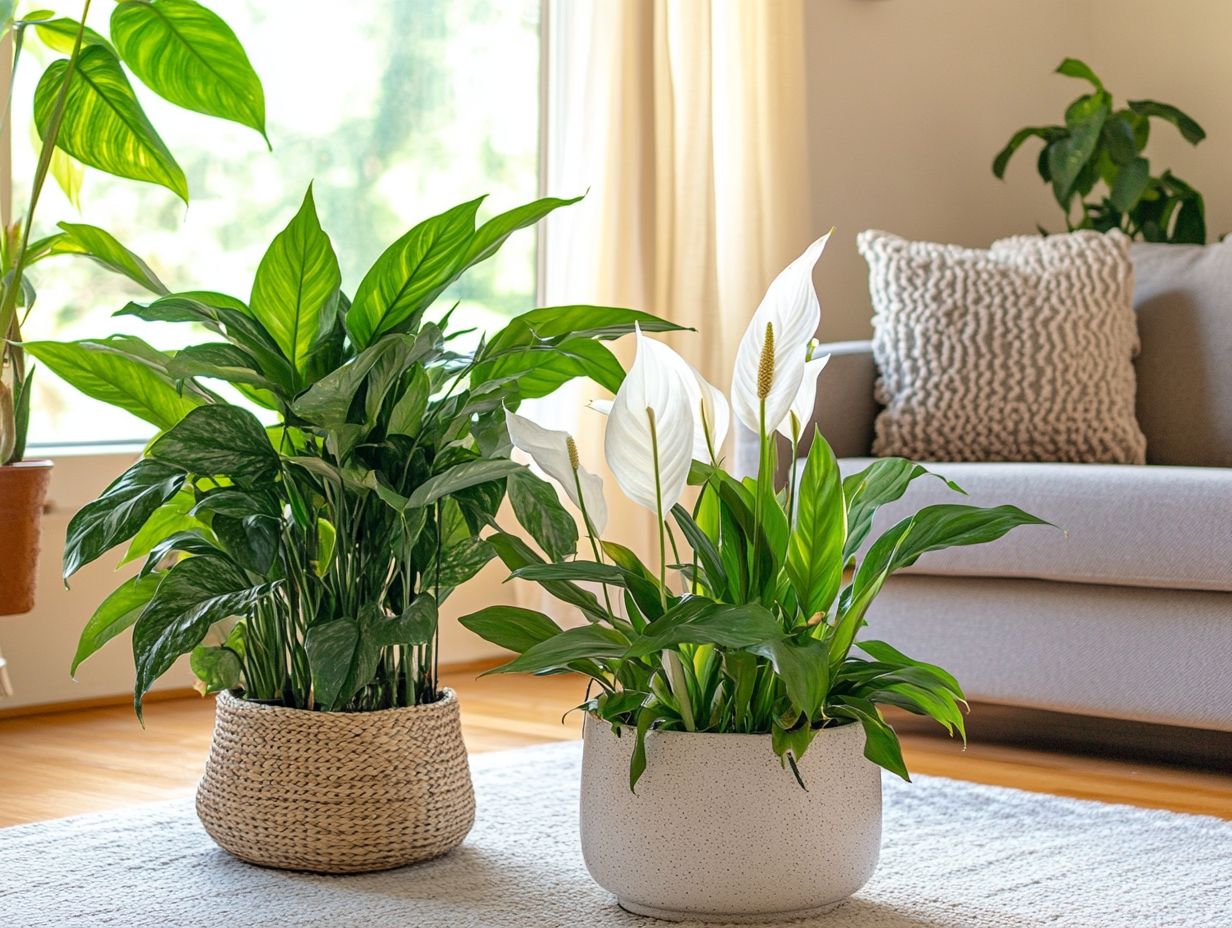
- Breathe easier and feel better indoor plants improve air quality and lift your mood.
- When choosing indoor plants for beginners, consider factors such as light, humidity, and maintenance level.
- Low maintenance options like succulents and pothos are great for beginners.
Benefits of Having Indoor Plants
Having indoor plants transcends mere aesthetics; it enriches your home environment with a multitude of benefits. These include better air quality and an uplifted mood.
Varieties such as the Heartleaf Philodendron (Philodendron hederaceum) and Pothos (Epipremnum aureum) excel at purifying the air. They are exceptional choices for those seeking a healthier living space.
Incorporating these low-maintenance houseplants into your home enhances your well-being. They also help you connect to community gardens and food justice initiatives.
Improving Air Quality and Mood
Houseplants like the Heartleaf Philodendron and Pothos aren t just pretty to look at; they can truly elevate your mood by purifying the air.
These verdant companions serve as natural air filters, absorbing toxins like formaldehyde, benzene, and xylene that tend to linger in indoor spaces. Through the process of making food, these plants release oxygen while breaking down harmful compounds, contributing to a cleaner atmosphere.
Bringing greenery into your space cultivates a sense of tranquility and well-being. This often helps to alleviate stress and anxiety. Research shows that being surrounded by houseplants can lift your mood, enhance productivity, and sharpen focus transforming them from mere decorative items into essential components of a healthier, more vibrant living or working environment.
Choosing the Right Indoor Plants for Beginners
Choosing the right indoor plants as a beginner might seem overwhelming. However, grasping the unique needs of different varieties can make the journey much smoother.
Consider popular choices like the ZZ plant and Aloe Vera. They re frequently recommended for their low-maintenance requirements and ability to thrive in various light conditions.
Choose easy-care plants to become a confident plant parent. You ll also unlock the beauty and benefits of indoor gardening.
Embrace the journey, and watch your space transform.
Factors to Consider
When you re choosing indoor plants, consider factors like light conditions, humidity levels, and your unique plant-care style to create a flourishing indoor garden.
Understanding how these elements interact can dramatically improve plant adaptability in your space. For example, taking note of natural light patterns throughout the day can help you determine whether a plant thrives in low or bright, indirect light.
Maintaining optimal humidity levels often achieved with humidifiers (machines that add moisture to the air) or by clustering plants can greatly impact overall health. This reduces stress and encourages growth.
Check for signs of distress, such as wilting leaves or stunted growth; these clues will signal when adjustments are necessary. Keep a care journal to monitor plant conditions.
Easy-to-Care-For Indoor Plants

If you’re in search of low-maintenance options, you’ll discover easy-care plants that are ideal for both novices and those with busy lifestyles. These plants deliver a unique aesthetic without the burden of demanding care routines.
Consider houseplants like the Fiddle Leaf Fig and the ZZ plant; they are not only forgiving but also fast-growing. These choices allow you to effortlessly enhance your indoor space with vibrant greenery while avoiding the stress of extensive upkeep.
Low Maintenance Options
Some of the most coveted low-maintenance plants include popular houseplants like the peace lily and Monstera deliciosa. These are readily available at big-box stores and online.
These plants aren t just easy to find; they re like little green superheroes, perfect for anyone looking to add life to their home! They are incredibly forgiving, making them ideal for both novice and experienced plant lovers.
The peace lily thrives in low light, requiring water only when the top inch of soil feels dry. Meanwhile, Monstera deliciosa boasts stunning, large leaves that effortlessly infuse a tropical vibe into any space.
You might also want to consider these other excellent options:
- Pothos: This beauty tolerates neglect and comes in a variety of colors.
- Snake plants: Renowned for their air-purifying properties and resilience.
Charming and affordably priced, these plants have gained immense popularity, allowing anyone to enjoy a touch of greenery without the stress of high maintenance.
How to Care for Indoor Plants
Caring for indoor plants requires you to embrace your distinctive plant-care style. It s essential to pay close attention to your watering schedules and adapt to the specific light conditions in your home.
By doing so, you ll create an environment that fosters optimal growth for your green companions.
Essential Care Tips
To ensure your indoor plants thrive, establishing a consistent watering schedule is essential. You should also understand their specific light conditions and how to grow new plants from cuttings.
Each variety comes with its own unique requirements that significantly impact its overall health. For instance, succulents thrive in a drier environment and need watering less frequently.
On the other hand, tropical plants flourish with increased humidity and regular moisture. Position your greenery correctly such as placing ferns in indirect sunlight this can truly make all the difference.
Monitor room temperature and ensure adequate air circulation to support growth, helping to prevent common issues like mold and pests.
By recognizing these nuances, you will cultivate a vibrant indoor ecosystem that reflects your dedication as a plant lover.
Common Mistakes to Avoid
Understanding common mistakes in indoor plant care can spare you the hassle of unnecessary trial and error. By grasping these insights, you can cultivate a successful plant-care routine that fosters robust, healthy growth.
Troubleshooting and Problem-Solving

Troubleshooting common issues like yellowing leaves or stunted growth requires a keen understanding of your plants’ adaptability. This allows you to fine-tune your plant-care approach.
For instance, when you notice yellowing leaves, it often signals a lack of a key nutrient that plants need to stay healthy. In such cases, introducing a balanced fertilizer can work wonders, restoring that vibrant green hue.
Conversely, if you re dealing with stunted growth, it might be a sign of insufficient light. Simply moving your plant closer to a window or employing a grow light could stimulate that much-desired vertical growth.
Remember, each plant type has its own set of preferences. While succulents thrive in drier conditions, ferns bask in humidity. By closely observing how your plants react and making the necessary adjustments, you can cultivate an optimal environment tailored to their unique needs, ultimately nurturing healthier growth.
Best Indoor Plants for Different Environments
Choosing the right indoor plants for various environments is crucial for their growth and longevity. By taking into account factors such as light conditions and humidity levels, you can significantly enhance their vitality and lifespan.
Plants for Low Light Conditions
Plants that flourish in low light conditions, like the ZZ plant and Chinese Evergreen, are perfect for spaces with limited natural light! Especially if you re just starting out.
These resilient options are not demanding and can bounce back from a bit of neglect. They bring a refreshing touch of greenery to those dull corners. The Snake plant, with its striking architectural leaves, is another excellent choice; it thrives on minimal water and can handle neglect like a champ. For those looking for more options, check out the best indoor plants for low light.
Spider plants, with their charming cascading trails, do well in less sunny areas. They appreciate a little occasional misting. Then there’s the Pothos, celebrated for its versatility; it adapts beautifully to lower light while injecting a vibrant splash of color into your space. If you’re curious about other options, check out the most resilient indoor plants to enhance your indoor garden.
Understand these plants needs, and watch them thrive in your home! Learn how often to water them and how humid they like their environment to ensure they flourish beautifully, even in the shadowy nooks of your home. They are perfect for both beginners and plant parents.
Plants for High Humidity Environments
In high-humidity environments, tropical plants like the peace lily and Fittonia truly come into their own. These are ideal choices for spaces like your bathroom or kitchen, alongside heartleaf philodendron and other popular houseplants.
These plants not only revel in the moisture-rich air but also boast vibrant foliage that can elevate the aesthetic of any room! This creates ideal conditions for a happy plant.
To ensure they thrive, maintain consistent humidity levels around 60% or higher. This can easily be achieved with the right watering schedule and by using a pebble tray a shallow dish filled with water and pebbles to create humidity. Position these green companions near windows that provide indirect sunlight to replicate their natural habitat and ensure they are in the right light conditions for their growth.
It’s wise to steer clear of placing them near drafts or air conditioning vents, as these can induce stress and undermine their health, impacting their overall plant adaptability.
With the right care in a humid environment, you ll find these plants flourishing beautifully! They can transform your space into a vibrant oasis that showcases your unique plant-care style.
Frequently Asked Questions
What are the Best Indoor Plants for Beginners?
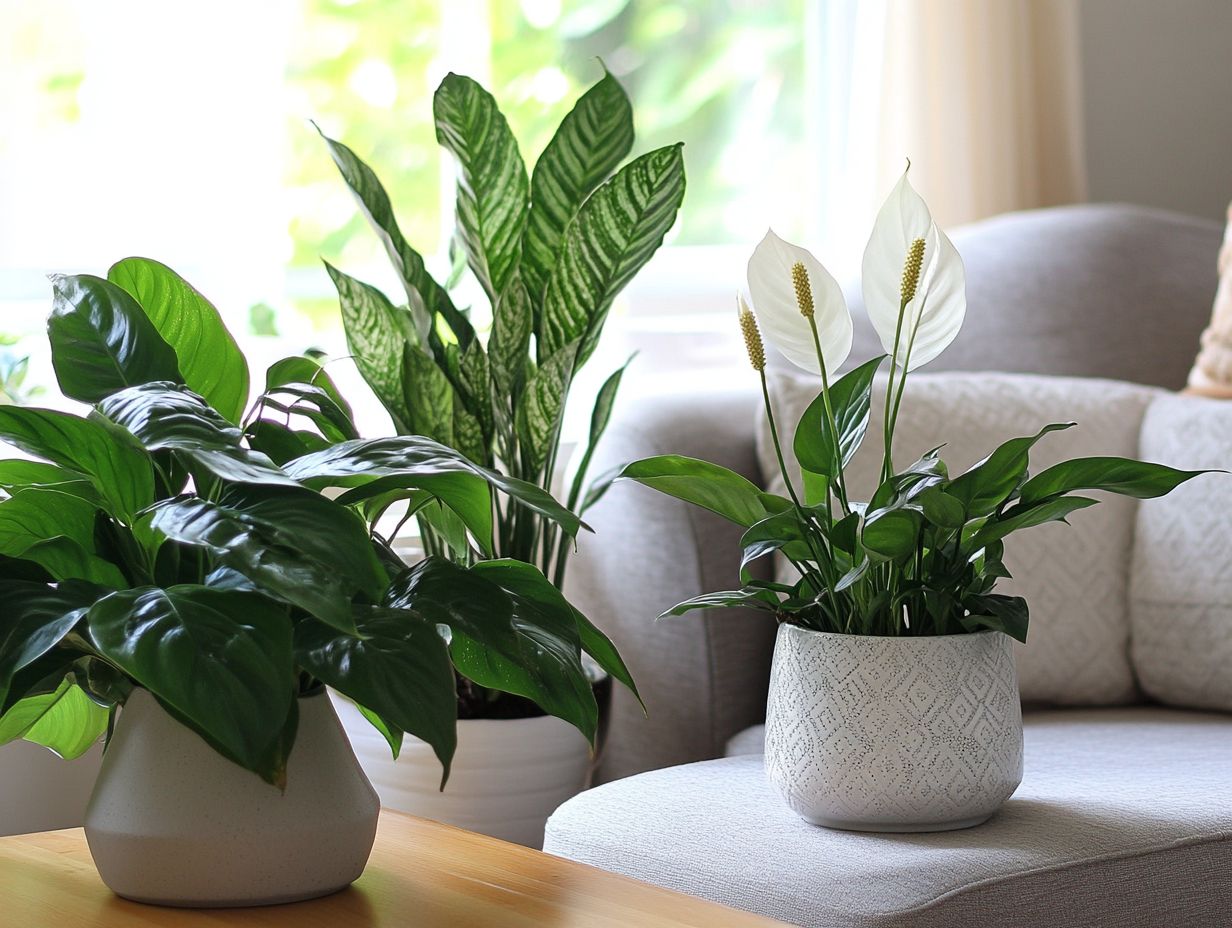
The best indoor plants for beginners are ones that are low-maintenance and can thrive in various environments. Examples include Pothos, spider plants, and peace lilies, all of which are easy-care plants.
What are the benefits of having indoor plants?
Indoor plants add aesthetic appeal to a space and also provide:
- Air purification
- Stress reduction
- Improved overall well-being
Do indoor plants require a lot of care?
It depends on the type of plant you choose. Some indoor plants, like succulents, require minimal care and can survive with infrequent watering. Others, like ferns, may require more attention, making them less forgiving than fast-growing varieties.
Can indoor plants be harmful to pets?
Yes, some indoor plants can be toxic to pets if ingested. It’s important to research the plant varieties you choose and keep them out of reach of your furry friends to ensure their safety.
What are some tips for caring for indoor plants?
Some general tips for caring for indoor plants include:
- Providing adequate sunlight
- Adhering to a regular watering schedule
- Periodically dusting the leaves to remove any build-up, thus ensuring the unique look of each plant is maintained.
Are there any indoor plants that are hard to kill?
Yes, several indoor plants are known for being very resilient and difficult to kill, such as snake plants, ZZ plants, and Chinese evergreens. These are great options for beginners who may not have a green thumb!
Don t wait start creating your indoor jungle today! What plant are you excited to start with?

